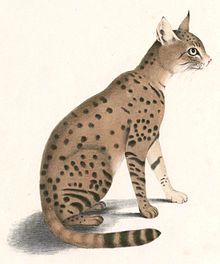Thomas Hardwicke
Thomas Hardwicke (* 1756 in Bourn ; † March 3, 1835 in The Lodge, Lambeth ) was a British general who was stationed in India, an amateur zoologist and botanist. Its botanical author abbreviation is “ Hardw. "
Life
Hardwicke joined the army of the British East India Company in 1778 , where he soon became a lieutenant in the artillery. From 1781 to 1785 he was stationed under Eyre Coote in southern India. He was involved in the relief of Vellore in 1782, in the siege of Cuddalore in 1783, was involved in the campaign against Tipu Sultan from 1790 to 1792 and in the Rohilla campaign in 1794. After being wounded at Satyamangalam in 1790 he was stationed in Bangalore and from 1793 in Bengal as an adjutant and artillery quartermasters. In 1819 he became major-general and commanded the artillery in Bengal. In 1823 he went back to England.
During his extensive travels in the Indian subcontinent he collected numerous animals and watercolors of native animals, which he had made by local (Indian) artists (some are by himself). In 1835 the extensive collection of 4,500 drawings came to the British Museum (later with its zoological collection to the Natural History Museum ). Around 200 of his watercolors were published after his death in the book Illustrations of Indian Zoology , which he sponsored , with texts by John Edward Gray and other zoologists. With Gray he published in 1827 about reptiles that he had collected in India. Hardwicke was in contact with zoologists and scientists in England such as Joseph Banks .
He first described the grave bats Taphozous longimanus , the gray goral ( Naemorhedus goral ) and the Indian bare-sole gerbil ( Tatera indica ). He was the first to describe the lesser panda (before the Linnean Society in 1821), but his specimen came to England late and when he published it in 1827, Georges Cuvier (1825) had already described the species after a specimen sent from India.
Hardwicke was not married but had several children from an Indian lover.
In 1813 he became a Fellow of the Royal Society and he was a Fellow of the Linnean Society of London .
Honors
After him the genus Hardwickia became Roxb. named from the legume family (Fabaceae). Several animal species are also named after him. After his death Thomas Horsfield at the British Museum described the bats Rhinopoma hardwickii and Kerivoula hardwickii from Hardwicke's collection . The orange-bellied leaf bird Chloropsis hardwickii and the sleeper ray species Temera hardwickii are named after him.
Fonts
- Sketches of plants growing about Plettenburg Bay ... , 1812
- with John Edward Gray : Illustrations of Indian Zoology, London, 2 volumes, 1830 to 1834, Volume 1, Archives , Volume 2, Archives
literature
- WR Dawson: On the History of Gray and Hardwicke's Illustrations of Indian Zoology, and Some Biographical Notes on General Hardwicke, Journal of the Society for the Bibliography of Natural History, Volume 2, 1946, pp. 55-69.
Individual evidence
- ↑ Lotte Burkhardt: Directory of eponymous plant names . Extended Edition. Botanic Garden and Botanical Museum Berlin, Free University Berlin Berlin 2018. [1]
Web links
- Author entry and list of the plant names described for Thomas Hardwicke at the IPNI
- Biography at Current Conservation (English)
| personal data | |
|---|---|
| SURNAME | Hardwicke, Thomas |
| BRIEF DESCRIPTION | British general and zoologist |
| DATE OF BIRTH | 1756 |
| PLACE OF BIRTH | Bourn |
| DATE OF DEATH | March 3, 1835 |
| Place of death | London Borough of Lambeth |

